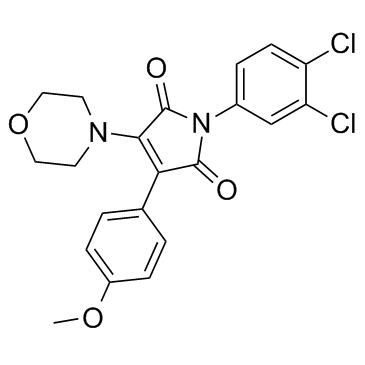1417162-36-7
| Name | 1-(3,4-dichloro-phenyl)-3-(4-methoxy-phenyl)-4-morpholin-4-yl-pyrrole-2,5-dione |
|---|---|
| Synonyms |
1H-Pyrrole-2,5-dione, 1-(3,4-dichlorophenyl)-3-(4-methoxyphenyl)-4-(4-morpholinyl)-
1-(3,4-Dichlorophenyl)-3-(4-methoxyphenyl)-4-(4-morpholinyl)-1H-pyrrole-2,5-dione RI-2 |
| Description | RI-2 is a reversible RAD51 inhibitor, with an IC50 of 44.17 μM, and specifically inhibits homologous recombination repair in human cells. |
|---|---|
| Related Catalog | |
| Target |
IC50: 44.17 μM (RAD51)[1] |
| In Vitro | RI-2 (7a) is a reversible RAD51 inhibitor, with an IC50 of 44.17 μM. RI-2 specifically inhibits homologous recombination repair in human cells. RI-2 (150 μM) induces a significant sensitization of cells[1]. |
| Cell Assay | HEK293 cells are plated into 96-well tissue culture plates at a density of 300 cells per well in the presence or absence of 50 nM mitomycin C (MMC) for 24 hours at 37°C, 5% CO2. Media is subsequently replaced with fresh media containing 0.5% DMSO plus RI-2 for an additional 24 hours. RI-2 is then removed, and cultures are allowed to grow to a 50-70% confluence. Average survival from at least three replicates is measured using CellGlo reagentor. RI-2 is deemed successful in sensitizing cells to MMC if they generate significantly greater toxicity in the presence of MMC relative to the absence of MMC. Specifically, sensitization is scored as a “+” when non-overlapping standard errors are observed for at least two pairs of compound doses[1]. |
| References |
| Density | 1.4±0.1 g/cm3 |
|---|---|
| Boiling Point | 605.6±55.0 °C at 760 mmHg |
| Molecular Formula | C21H18Cl2N2O4 |
| Molecular Weight | 433.285 |
| Flash Point | 320.1±31.5 °C |
| Exact Mass | 432.064362 |
| PSA | 59.08000 |
| LogP | 4.25 |
| Vapour Pressure | 0.0±1.7 mmHg at 25°C |
| Index of Refraction | 1.645 |
| Storage condition | 2-8℃ |
